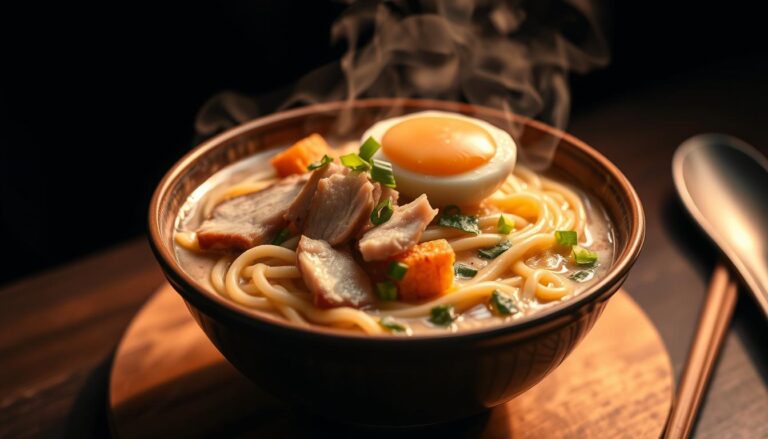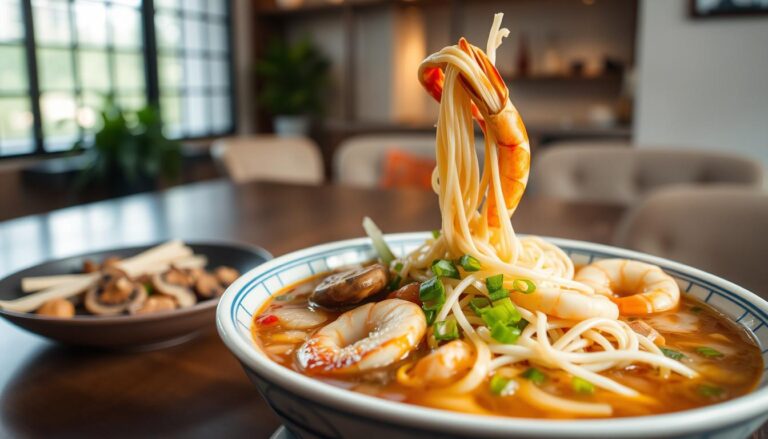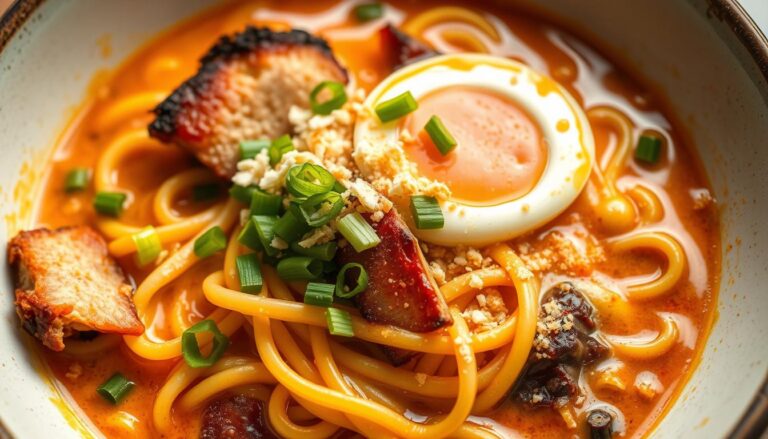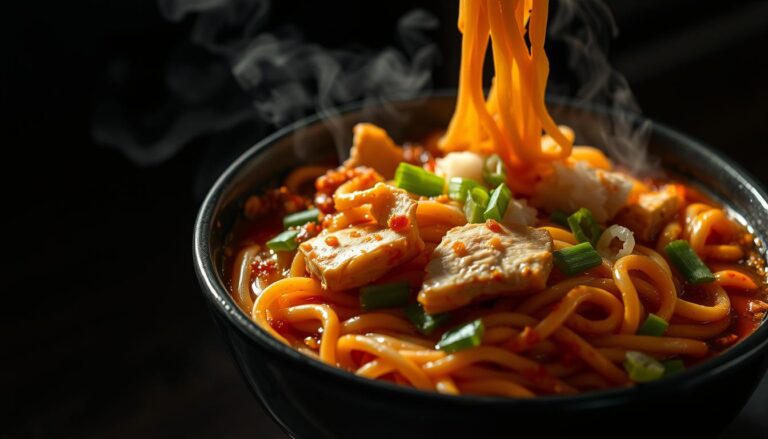Gluten Free Ramen Recipe – Rice Noodles (GF), Tamari (GF)
Finding a tasty gluten free ramen recipe is easier than you think. My homemade ramen noodles solution brings authentic Asian flavors to your kitchen. It shows that you don’t have to give up taste, even with dietary restrictions.
Gluten-free cooking can be tough, but ramen is a big challenge. Traditional ramen recipes often include wheat, which is a no-go for those with gluten sensitivities. So, I’ve made a simple gluten free ramen recipe. It uses rice noodles and gluten-free tamari instead.
In just 30 minutes, you can make a bowl of ramen that’s safe for gluten-sensitive diets. It’s also full of rich, comforting flavors. The key is using the right ingredients: rice noodles and tamari, a premium gluten-free soy sauce alternative.
If you have celiac disease, are exploring gluten-free options, or just want to try something new, this recipe is perfect. I’ll walk you through each step. This way, your homemade ramen noodles will always be perfect.
Get ready to turn your kitchen into a ramen paradise – without gluten, but full of flavor!
Understanding Gluten Free Ramen Essentials
Ramen lovers with gluten sensitivities, rejoice! Making delicious gluten free Asian noodles is easy. Traditional ramen often has wheat, which can cause health issues.
Exploring gluten-free ramen means knowing the differences. We’ll look at why some ramen is hard for those with gluten sensitivities.
What Makes Traditional Ramen Non-Gluten Free
- Wheat flour noodles: Primary gluten source in classic ramen
- Soy sauce: Often contains wheat derivatives
- Flavor packets: May include gluten-containing additives
- Broth bases: Can include wheat-based thickeners
Benefits of Rice-Based Ramen Alternatives
Rice noodles are great for easy ramen soup recipes. They offer many benefits:
- Lighter texture and digestibility
- Authentic Asian culinary experience
- Versatile flavor absorption
- Nutritionally comparable to wheat noodles
Key Ingredients for Gluten Free Success
Creating perfect gluten-free ramen needs smart ingredient choices. Choose naturally gluten-free items for great taste and texture.
- Rice noodles: 8 oz, medium-sized
- Tamari: 2 tbsp, gluten-free soy sauce alternative
- Vegetable or chicken broth: 4 cups, homemade preferred
- Fresh vegetables and proteins for garnish
With these tips, you can make ramen safe and tasty for everyone.
Essential Ingredients for Perfect Gluten Free Ramen Recipe

Starting a delicious gluten-free noodle bowl means picking the right ingredients. Your healthy ramen dishes need ingredients that are both tasty and safe for your diet.
For a solid base of your gluten-free ramen, you’ll need a few important things:
- Rice Noodles: 8 oz, medium-width, gluten-free certified
- Broth: 4 cups, low-sodium, gluten-free chicken or vegetable base
- Protein: Chicken thighs or tofu, 4-6 oz, boneless
- Vegetables: Bok choy, mushrooms, green onions
The secret to a great gluten-free noodle bowl is its flexibility. Tamari sauce adds that special umami flavor without gluten. Use 2 tablespoons of gluten-free tamari to boost your ramen’s taste.
Choosing your protein can change your ramen. Chicken is a great choice, but tofu or tempeh are good for vegetarians. The goal is to mix textures and flavors for a dish that’s both filling and healthy.
Quality of ingredients is key to a great dish. Always check labels to make sure everything is gluten-free, like broths and sauces.
Creating the Perfect Gluten Free Ramen Broth
Making a great gluten free ramen broth needs focus on ingredients and how you do it. The key to a memorable ramen is its rich, tasty base. This base should excite your taste buds and fit dietary needs.

Learning about gluten free ramen seasonings can turn a basic soup into a feast. I’ll show you the key parts that make your vegetarian ramen recipe stand out.
Broth Base Components
- Vegetable stock: 4 cups, organic and gluten-free
- Water: 2 cups, filtered
- Kombu: 1 large sheet for umami depth
Seasoning and Flavor Enhancement
| Ingredient | Quantity | Purpose |
|---|---|---|
| Tamari | 2 tbsp | Gluten-free soy sauce alternative |
| Ginger | 1 inch, fresh | Aromatic warmth |
| Garlic | 2 cloves, minced | Flavor complexity |
Temperature and Timing Considerations
- Start with low heat: Allows flavors to develop gradually
- Simmer for 20-30 minutes: Intensifies broth depth
- Strain ingredients: Ensures smooth, clean texture
Creating the perfect gluten free ramen broth is an art. My secret is patience – slow cooking brings out amazing flavors. Taste as you go, adjusting seasonings to match your taste.
Rice Noodle Selection and Preparation Techniques
Choosing the right rice noodles is key for a great gluten-free instant ramen. Rice noodles have a nice texture and cook fast. They’re perfect for homemade ramen noodles.
- Thickness: Medium-width noodles are best for a traditional ramen feel
- Gluten-free certification: Make sure the packaging says it’s gluten-free
- Cooking time: Most rice noodles cook in 3-4 minutes
Here’s a detailed guide to preparing rice noodles for your gluten-free ramen:
- Choose 8 oz of certified gluten-free rice noodles
- Heat water to a rolling boil in a big pot
- Add noodles and cook for 3-4 minutes
- Drain and rinse with cold water to stop cooking
| Noodle Type | Cooking Time | Texture |
|---|---|---|
| Thin Rice Noodles | 2-3 minutes | Delicate |
| Medium Rice Noodles | 3-4 minutes | Perfect for Ramen |
| Wide Rice Noodles | 4-5 minutes | Hearty |
For those who love to try new things, making homemade ramen noodles is possible. You can use rice flour and tapioca starch. It takes more work but adds a personal touch to your gluten-free ramen.
Step-by-Step Cooking Instructions
Making an easy ramen soup recipe needs care and precision. I’ll guide you through the key steps to make a tasty gluten-free ramen. It will impress your taste buds and fulfill your comfort food cravings.

Creating a perfect gluten-free ramen involves three main stages: making the broth, preparing the noodles, and assembling the dish. Each stage is vital for rich flavors and textures.
Broth Preparation Process
Starting with a flavorful broth is key to a great ramen. Follow these steps to make a delicious gluten-free base:
- Heat sesame oil in a large pot: 1 tsp
- Sauté minced garlic: 2 cloves
- Add grated ginger: 1 inch
- Pour gluten-free broth: 4 cups
- Add tamari sauce: 2 tbsp
- Simmer for 20 minutes
Noodle Cooking Method
Rice noodles are the best choice for gluten-free Asian noodles in this recipe. Cooking them right ensures the best taste and texture:
- Boil water in a separate pot
- Add gluten-free rice noodles: 8 oz
- Cook according to package instructions
- Drain and rinse with cold water
- Set aside until ready to serve
Assembly and Garnishing
The last step turns your ingredients into a top-notch easy ramen soup recipe. Here’s how to plate it:
| Component | Quantity | Preparation |
|---|---|---|
| Rice Noodles | 1 serving | Place in bowl |
| Hot Broth | 1 cup | Ladle over noodles |
| Green Onions | 2 stalks | Thinly sliced |
| Soft-Boiled Egg | 1 egg | Halved |
| Nori Sheets | 1 sheet | Cut into strips |
Your gluten-free ramen is now ready to enjoy! Feel free to add more toppings and make it your own.
Customizable Toppings and Add-ins
Turn your gluten free noodle bowl into a masterpiece with exciting toppings. The right mix can make your healthy ramen dishes amazing.
Adding protein can make your ramen a full meal. Here are some tasty options:
- Soft-boiled eggs: 1 per serving, perfectly cooked for 6 minutes
- Shredded chicken: 4 oz, lean and tender
- Thinly sliced pork belly: 2 oz, crispy edges
- Tofu cubes: 3 oz, firm and pan-seared
Vegetables add color, nutrition, and texture. My top picks include:
- Fresh baby spinach: 1 cup
- Sliced shiitake mushrooms: 1/2 cup
- Roasted bok choy: 1/2 cup
- Julienned carrots: 1/4 cup
Aromatics and finishing touches add incredible flavor:
- Sliced green onions: 2 tablespoons
- Toasted sesame seeds: 1 teaspoon
- Chili oil: 1 teaspoon
- Fresh cilantro: 1 tablespoon, chopped
Remember, balance is key. Choose toppings that mix textures and flavors well. Try different combinations to find your favorite gluten free noodle bowl!
Storage and Meal Prep Tips
Preparing an easy ramen soup recipe doesn’t mean sacrificing flavor or quality. Smart storage and meal prep strategies can help you enjoy delicious gluten free ramen whenever hunger strikes. The key is understanding how to preserve each component of your dish for maximum taste and convenience.
Proper Storage Methods
Storing your gluten free ramen components requires careful attention to maintain freshness and texture. Here are my top storage recommendations:
- Broth: Store in an airtight container (32 oz, glass preferred) in the refrigerator for up to 3 days
- Rice noodles: Keep uncooked noodles in their original packaging, sealed tightly
- Toppings: Chop and store separately in sealed containers
- Cooked proteins: Refrigerate in individual portions for easy reheating
Reheating Instructions
Bringing your easy ramen soup recipe back to life requires gentle reheating. Follow these steps to maintain the best flavor and texture:
- Warm broth in a pot over medium-low heat
- Cook fresh rice noodles just before serving
- Reheat toppings and proteins separately to prevent overcooking
- Assemble bowl immediately after heating components
Make-Ahead Strategies
Transform your gluten free ramen recipe into a quick weeknight meal with these make-ahead tips. Prep components in advance to streamline your cooking process. Broth can be made in large batches and frozen for up to one month. Chop vegetables and proteins ahead of time, storing them in separate containers. When ready to eat, simply reheat and combine for a fresh, delicious meal in minutes.
Health Benefits and Dietary Considerations
Making healthy ramen is more than just cooking. Gluten free Asian noodles are a great choice for those looking for tasty, healthy meals. Rice noodles are a good base for many diets, providing important nutrients.
Gluten free ramen can be very nutritious if made with the right ingredients. Rice noodles are gluten-free but keep the dish tasty and filling. They are also good for your digestion and energy levels.
- Rice noodles: Low in fat, easy to digest
- Vegetable additions: Boost fiber and micronutrient content
- Protein sources: Enhance muscle recovery and satiety
- Broth ingredients: Support immune system function
| Nutrient | Benefit | Recommended Amount |
|---|---|---|
| Protein | Muscle maintenance | 15-20g per serving |
| Fiber | Digestive health | 3-5g per serving |
| Vitamins | Immune support | Multiple micronutrients |
People with dietary restrictions will love gluten free Asian noodles. By choosing quality ingredients and adding lots of veggies, you can make a nutritious ramen dish.
Conclusion
Making a tasty gluten free ramen at home is more than a challenge. It’s a chance to play with flavors and techniques. This turns simple ingredients into a memorable meal.
Your gluten free ramen journey shows how easy gourmet cooking can be. By choosing rice noodles, making a rich broth, and adding fresh toppings, you’ve opened up a world of flavors. Each bowl is a win, showing you can enjoy complex dishes without gluten.
Cooking is always a learning process. Every time you make this ramen, you get better. You’ll find new flavors and grow more confident in the kitchen. This recipe shows that you can enjoy great food, even with dietary limits.
So, get your favorite bowl ready and start cooking. Your homemade ramen noodles are ready to share a delicious story, one bowl at a time.







